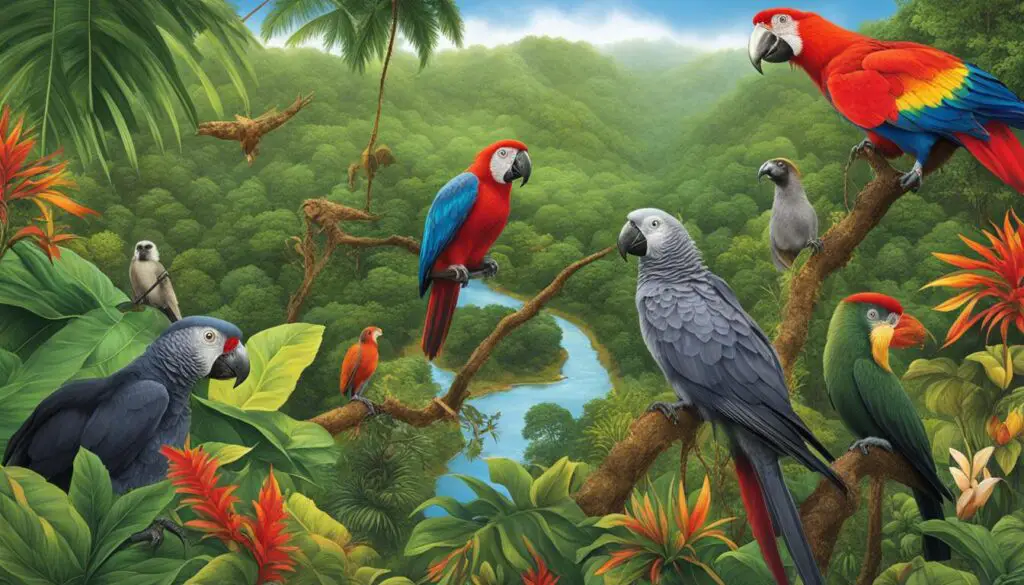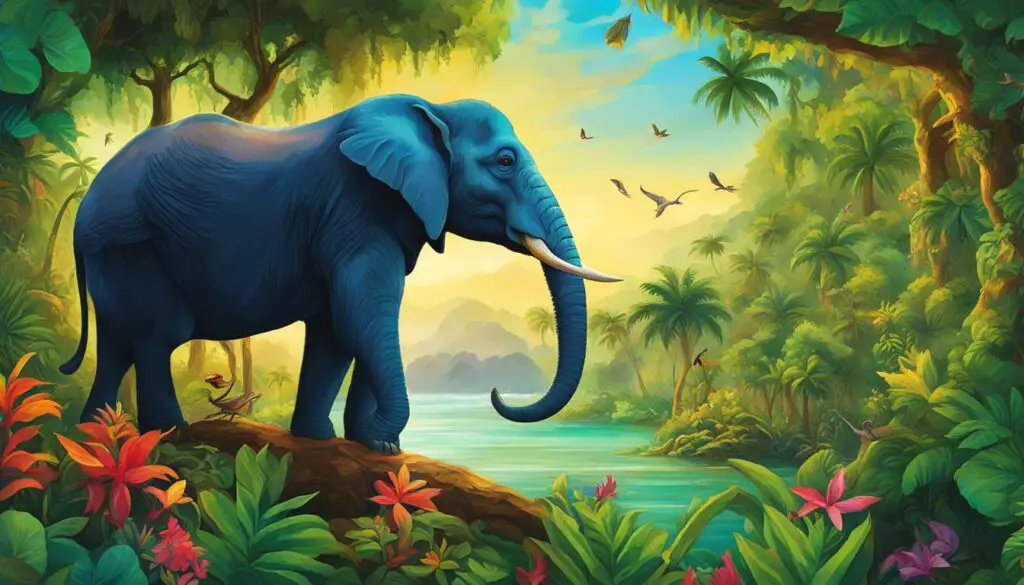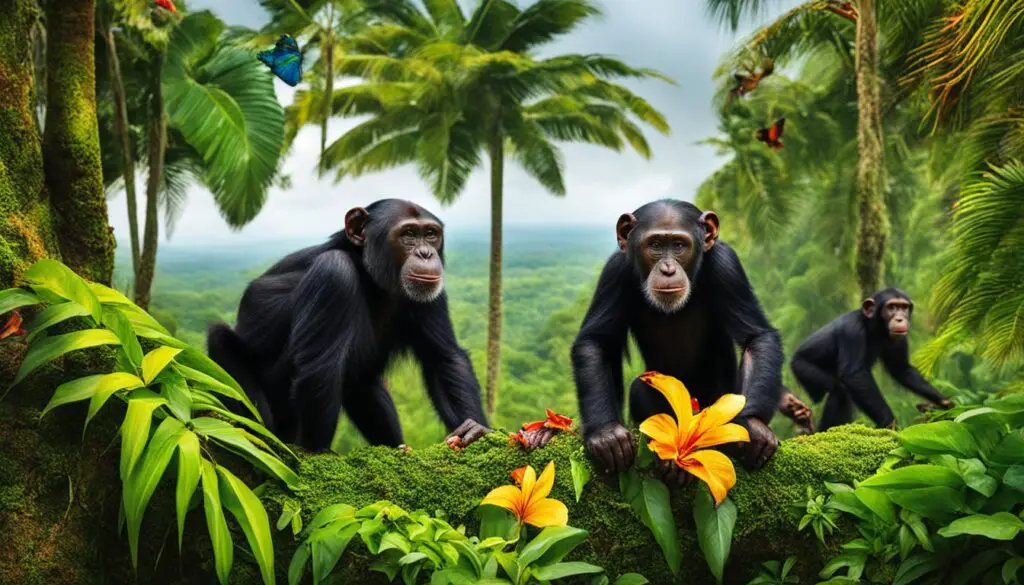Equatorial Guinea is a country renowned for its rich biodiversity and diverse range of animal species. With its lush rainforests, coastal areas, and unique habitats, Equatorial Guinea provides a natural haven for a wide variety of wildlife.

Home to approximately 3,250 species of plants, Equatorial Guinea is a biodiversity hotspot. Its animal diversity is equally impressive, with at least 194 mammal species, 418 bird species, and 91 reptile species calling the country home. Some of the notable animals found in Equatorial Guinea include gorillas, leopards, chimpanzees, African elephants, and various species of monkeys.
Equatorial Guinea’s commitment to wildlife conservation is evident in its efforts to protect these valuable animal species and their habitats. The country has established a network of protected areas, covering about 20% of its uplands, to safeguard the diverse ecosystems and provide a safe haven for wildlife.
Key Takeaways:
- Equatorial Guinea is home to a diverse range of animal species, including gorillas, leopards, and African elephants.
- The country boasts approximately 3,250 species of plants, making it a hotspot for biodiversity.
- Equatorial Guinea has established protected areas covering 20% of its uplands to preserve wildlife habitats.
- Conservation efforts are crucial for protecting endangered species, such as forest elephants and western lowland gorillas.
- Equatorial Guinea’s commitment to wildlife conservation ensures the long-term survival of its remarkable animal species.
Wildlife Conservation Efforts in Equatorial Guinea
Equatorial Guinea understands the significance of wildlife conservation and has taken proactive measures to protect its unique animal species. The country has established a network of protected areas, with approximately 20% of its uplands designated as protected zones. These areas serve as vital habitats for a diverse range of wildlife and aim to safeguard their populations.
Equatorial Guinea collaborates with esteemed organizations such as the National Institute of Forestry Development and Protected Areas Management to conduct comprehensive research and surveys. These initiatives help in better understanding and monitoring the local wildlife population. By gathering essential data, Equatorial Guinea can implement targeted conservation strategies to mitigate risks and ensure their preservation.
“Our priority is to conserve Equatorial Guinea’s remarkable wildlife for future generations,” says Dr. Maria Nsue, the director of the National Institute of Forestry Development and Protected Areas Management. “Through research, habitat preservation, and community engagement, we are committed to the long-term sustainability of our diverse animal species.”
The conservation efforts in Equatorial Guinea encompass various aspects of wildlife protection, such as anti-poaching measures and habitat restoration initiatives. Equatorial Guinea has taken stringent actions against illegal hunting and poaching activities that pose a significant threat to the survival of endangered species.
By motivating local communities to actively participate in wildlife conservation and promoting sustainable practices, Equatorial Guinea ensures the engagement and support of those directly impacted by conservation strategies. It is a collaborative effort involving government agencies, conservation organizations, researchers, and local communities to safeguard the invaluable wildlife heritage of Equatorial Guinea.
In summary, Equatorial Guinea’s commitment to wildlife conservation is evident through its establishment of protected areas, research collaborations, and community engagement. These efforts are instrumental in preserving the unique animal species found in the country and ensuring their long-term survival.
| Conservation Initiatives | Significance |
|---|---|
| Establishment of protected areas | Preserves habitats and provides safe havens for wildlife |
| Research collaborations and surveys | Enhances understanding and monitoring of local wildlife populations |
| Anti-poaching measures | Addresses the threats faced by endangered species |
| Community engagement | Promotes sustainable practices and fosters local support |
| Collaboration with government agencies and conservation organizations | Ensures effective implementation of conservation strategies |
Endangered Species in Equatorial Guinea
Equatorial Guinea is home to several endangered species that require special attention and conservation efforts. Among these endangered species are the forest elephant, which is a subspecies of the African elephant, and the western lowland gorilla. Both of these species face significant threats from habitat loss, poaching, and human-wildlife conflict. Protecting the habitats of these endangered species and implementing strategies to combat poaching are essential for their survival. Efforts are also being made to raise awareness about the importance of these endangered species and promote their conservation on a global scale.
To understand the plight of the endangered species in Equatorial Guinea, let’s take a closer look at the threats and conservation efforts surrounding the forest elephant and the western lowland gorilla.
Forest Elephant
The forest elephant (scientific name: Loxodonta cyclotis) is a subspecies of the African elephant found primarily in the forests of Equatorial Guinea. These gentle giants not only play a crucial role in maintaining the balance of their ecosystems but also act as important seed dispersers, contributing to the regrowth and diversity of the rainforest.
However, the forest elephant population in Equatorial Guinea has dramatically declined in recent years due to various factors. Illegal hunting for ivory, driven by the demand for elephant tusks, remains a significant threat. Additionally, the loss of forest habitat due to deforestation, both for agriculture and logging, further exacerbates the challenges faced by these magnificent creatures.
To protect the forest elephant, it is crucial to safeguard its remaining habitat and crack down on illegal hunting and poaching activities. Efforts are being made to establish protected areas and improve law enforcement against wildlife trafficking. These initiatives aim to ensure the long-term survival of the forest elephant and preserve the ecological balance of Equatorial Guinea’s forests.
Western Lowland Gorilla
The western lowland gorilla (scientific name: Gorilla gorilla gorilla) is another endangered species in Equatorial Guinea. These majestic primates are known for their intelligence, social structures, and close genetic relationship to humans.
Western lowland gorillas face similar threats to the forest elephant, including habitat destruction and poaching. The expansion of human settlements, agriculture, and commercial logging activities encroaches on their natural habitat, leaving these gorillas vulnerable. Additionally, gorillas are often targeted by poachers for bushmeat and the illegal wildlife trade.
Conservation efforts for the western lowland gorilla focus on creating protected areas, raising awareness about their importance, and supporting local communities living near gorilla habitats. These efforts aim to reduce human-wildlife conflict, provide alternative livelihoods that do not rely on hunting or poaching, and foster coexistence between humans and gorillas.
In summary, protecting endangered species like the forest elephant and western lowland gorilla in Equatorial Guinea requires a holistic approach that addresses habitat conservation, law enforcement, and community engagement. Collaborative efforts between government authorities, conservation organizations, local communities, and global partners can make a significant impact in preserving these unique and irreplaceable creatures.
Please note that the table presented as part of this section is not included in this text and will be added separately.
Animal Habitats in Equatorial Guinea
Equatorial Guinea is blessed with diverse habitats that provide a haven for its rich animal population. From lush rainforests to coastal zones, the country offers a range of ecosystems that support a wide variety of species.
The rainforests of Equatorial Guinea are particularly noteworthy, known for their remarkable biodiversity. These forests are home to numerous endangered and endemic species, making them a vital habitat for the region’s unique wildlife. Among the inhabitants of these rainforests are gorillas, chimpanzees, and an array of bird species, each contributing to the rich tapestry of life in Equatorial Guinea.
The coastal areas of Equatorial Guinea also play host to a diverse marine ecosystem. These waters are teeming with a plethora of fish, crustaceans, and marine mammals, further enhancing the country’s biodiverse offerings. Protecting these habitats is of utmost importance to preserve the precious wildlife that calls Equatorial Guinea home.

Key Animal Habitats in Equatorial Guinea:
| Habitat | Key Species |
|---|---|
| Rainforests | Gorillas, Chimpanzees, Birds |
| Coastal Zones | Fish, Crustaceans, Marine Mammals |
Preserving these vital habitats not only ensures the survival of the remarkable animal species found in Equatorial Guinea but also helps maintain the country’s unique wildlife heritage. By protecting and carefully managing these habitats, Equatorial Guinea can continue to thrive as a haven for diverse animal life.
Wildlife Tourism and Photography in Equatorial Guinea
Equatorial Guinea’s rich wildlife and natural beauty make it an attractive destination for wildlife tourism and photography. The country offers opportunities to observe and photograph a variety of animals in their natural habitats, including the iconic gorillas and elephants.
Guided wildlife tours and photography workshops provide visitors with the chance to explore the diverse ecosystems of Equatorial Guinea and capture stunning images of its unique wildlife. Whether you’re a professional wildlife photographer or a nature enthusiast with a camera, this country offers countless breathtaking moments to capture.
Explore the Wonder of Equatorial Guinea’s Wildlife
Equatorial Guinea’s wildlife offers a visual feast for tourists and photographers. Imagine capturing the image of a majestic gorilla as it gracefully moves through the dense rainforest, or witnessing a herd of elephants bathing in a serene river. These awe-inspiring moments can be found in Equatorial Guinea’s protected areas, where wildlife thrives.
The country’s national parks, such as Monte Alén National Park and Pico Basilé National Park, provide a safe haven for a wide range of animal species. These protected areas offer visitors the chance to get up close and personal with diverse wildlife, all while maintaining responsible and ethical practices to ensure the well-being and conservation of the animals.
Photography Tips for Capturing Equatorial Guinea’s Wildlife
To make the most of your wildlife photography experience in Equatorial Guinea, here are a few tips:
- Invest in a telephoto lens: A telephoto lens will allow you to capture detailed close-ups of animals from a safe distance, preserving their natural behavior.
- Be patient: Wildlife photography requires patience. Spend time observing the animals and waiting for the perfect moment to capture their unique behaviors.
- Respect the animals’ space: Maintain a safe distance from the wildlife to avoid disturbing their natural behavior and potentially endangering yourself or the animals.
- Follow ethical guidelines: Abide by ethical guidelines and respect the environment. Do not litter or disturb the animals’ habitats.
With these tips in mind, you can create captivating and respectful wildlife photographs that showcase the beauty and importance of Equatorial Guinea’s wildlife.

Equatorial Guinea offers a unique and rewarding wildlife tourism and photography experience. The country’s commitment to conservation and responsible practices ensures that future generations can continue to appreciate and protect its remarkable wildlife.
Challenges in Wildlife Conservation in Equatorial Guinea
Despite the efforts made in wildlife conservation, Equatorial Guinea faces several challenges in protecting its diverse animal species. Illegal hunting and poaching pose a significant threat to the survival of endangered species, such as elephants and gorillas. Habitat loss, primarily due to deforestation and land conversion for agriculture, further exacerbates the issue. Limited resources and funding for conservation initiatives also hamper effective wildlife management and protection. Addressing these challenges requires the collaboration of government agencies, conservation organizations, local communities, and international partners to implement sustainable conservation strategies and raise awareness about the importance of protecting Equatorial Guinea’s unique wildlife.
One of the main challenges in wildlife conservation in Equatorial Guinea is the issue of illegal hunting and poaching. This illegal activity not only threatens the survival of endangered species such as elephants and gorillas but also disrupts the delicate balance of the ecosystem. Equatorial Guinea must strengthen its law enforcement efforts and implement stricter penalties to deter poachers and protect its precious wildlife.
Additionally, habitat loss due to deforestation poses a significant challenge in wildlife conservation. The expanding agricultural industry and unsustainable logging practices contribute to the destruction of natural habitats, leaving animals without essential resources and disrupting their natural habitats. Addressing this challenge requires the implementation of sustainable land-use practices and the promotion of alternative livelihoods that do not harm the environment.
“Illegal hunting and habitat loss are major challenges in wildlife conservation in Equatorial Guinea. The government and various stakeholders must come together to develop and implement effective strategies to combat these threats and safeguard the country’s unique wildlife.” – Conservation Expert
Limited resources and funding are also obstacles in wildlife conservation efforts. Equatorial Guinea, like many developing countries, faces budgetary constraints and competing priorities. To overcome this challenge, partnerships between government agencies, conservation organizations, local communities, and international donors are crucial. These collaborations can mobilize resources, knowledge, and expertise to support wildlife conservation initiatives in Equatorial Guinea.
Raising awareness about the importance of protecting Equatorial Guinea’s unique wildlife is another challenge that needs to be addressed. Many people are unaware of the ecological significance and economic value of wildlife conservation. By promoting education and engaging local communities in conservation efforts, Equatorial Guinea can foster a culture of environmental stewardship and ensure long-term support for wildlife conservation.
Challenges in Wildlife Conservation in Equatorial Guinea
| Challenges | Impact | Potential Solutions |
|---|---|---|
| Illegal hunting and poaching | Threat to endangered species and ecosystem balance | Strengthen law enforcement efforts, stricter penalties, and conservation awareness |
| Habitat loss due to deforestation | Disruption of natural habitats and resource deprivation for animals | Implementation of sustainable land-use practices, reforestation initiatives, and alternative livelihoods |
| Limited resources and funding | Obstacle in implementing conservation programs effectively | Partnerships between government agencies, conservation organizations, local communities, and international donors |
| Lack of awareness | Insufficient support and understanding for wildlife conservation | Promotion of education, community engagement, and awareness campaigns |
Conclusion
Equatorial Guinea is a treasure trove of wildlife, showcasing a remarkable array of animal species and habitats. With its vast biodiversity and unique ecosystems, the country holds a special place in the realm of conservation. The protection of Equatorial Guinea’s diverse animal species and their habitats is of paramount importance for preserving its rich biodiversity and ensuring the survival of these extraordinary creatures for future generations.
Efforts to safeguard Equatorial Guinea’s wildlife are being carried out through dedicated wildlife conservation initiatives. By implementing strategies aimed at combating illegal hunting, poaching, and habitat loss, Equatorial Guinea is taking crucial steps to protect its endangered animal species, such as the forest elephants and western lowland gorillas. These conservation efforts not only contribute to the preservation of Equatorial Guinea’s unique wildlife but also play a vital role in maintaining the country’s ecological balance.
Collaboration between Equatorial Guinea and international partners is key to ensuring successful wildlife conservation. Through partnerships with conservation organizations and the engagement of local communities, Equatorial Guinea can strengthen its conservation efforts by leveraging the expertise, resources, and collective determination to address the challenges it faces. Additionally, responsible and sustainable tourism practices that prioritize the welfare of the animals and their habitats can provide economic incentives for conservation and facilitate the appreciation of Equatorial Guinea’s remarkable wildlife.
In conclusion, Equatorial Guinea’s wildlife is a precious asset that needs our protection and stewardship. By embracing wildlife conservation as a collective responsibility, Equatorial Guinea and its partners can secure a brighter future for the country’s unique animal species, preserve its rich biodiversity, and continue to be a source of inspiration and wonder for generations to come.
FAQ
How many species of animals are found in Equatorial Guinea?
Equatorial Guinea is home to approximately 194 mammal species, 418 species of birds, and 91 reptile species.
What are some notable mammal species found in Equatorial Guinea?
Notable mammal species found in Equatorial Guinea include gorillas, leopards, chimpanzees, African elephants, hippopotamuses, Cape buffalo, crocodiles, pythons, and various species of monkeys.
What initiatives has Equatorial Guinea implemented for wildlife conservation?
Equatorial Guinea has established a network of protected areas, with approximately 20% of its uplands designated as protected zones. The country also collaborates with organizations to conduct research and surveys, monitor wildlife populations, and implement conservation strategies.
Which animal species in Equatorial Guinea are endangered?
The forest elephant and the western lowland gorilla are among the endangered species in Equatorial Guinea.
What kind of habitats support Equatorial Guinea’s diverse animal population?
Equatorial Guinea’s diverse animal population is supported by a range of habitats, including lush rainforests and coastal zones.
Is Equatorial Guinea a good destination for wildlife tourism and photography?
Yes, Equatorial Guinea offers opportunities for wildlife tourism and photography, allowing visitors to observe and photograph animals such as gorillas and elephants in their natural habitats.
What are the challenges in wildlife conservation in Equatorial Guinea?
The challenges in wildlife conservation in Equatorial Guinea include illegal hunting, poaching, habitat loss, and limited resources and funding for conservation efforts.
